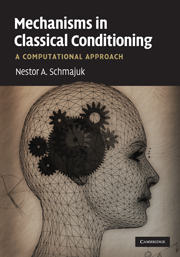Book contents
- Frontmatter
- Contents
- Preface
- Acknowledgments
- Abbreviations
- Part I Introduction
- Part II Attentional and associative mechanisms
- Part III Configural mechanisms
- 11 A configural model of conditioning
- 12 Occasion setting
- 13 The neurobiology of occasion setting
- Part IV Attentional, associative, configural and timing mechanisms
- Part V Conclusion: mechanisms of classical conditioning
- References
- Author Index
- Subject Index
13 - The neurobiology of occasion setting
from Part III - Configural mechanisms
Published online by Cambridge University Press: 23 May 2010
- Frontmatter
- Contents
- Preface
- Acknowledgments
- Abbreviations
- Part I Introduction
- Part II Attentional and associative mechanisms
- Part III Configural mechanisms
- 11 A configural model of conditioning
- 12 Occasion setting
- 13 The neurobiology of occasion setting
- Part IV Attentional, associative, configural and timing mechanisms
- Part V Conclusion: mechanisms of classical conditioning
- References
- Author Index
- Subject Index
Summary
As described in Chapter 12, Schmajuk, Lamoreux and Holland (SLH) (1998) showed that an extension of a neural network model introduced by Schmajuk and DiCarlo (SD) (1992) characterizes many of the differences that distinguish simple conditioning from occasion setting.
In the framework of their model, Schmajuk and DiCarlo (1992) proposed that the hippocampus modulates (a) the competition among simple and complex stimuli to establish associations with the unconditioned stimulus, and (b) the configuration of simple stimuli into complex stimuli. Furthermore, Schmajuk and Blair (1993, 1995) suggested that (a) nonselective aspiration lesions of the hippocampal formation impair both configuration and competition, and (b) ibotenic acid selective lesions of the hippocampus proper impair only stimulus configuration.
These assumptions are somewhat similar to the ones made in Chapter 6 for the SLG model, in which we assumed that CS1–CS2, CS–CX, CX–CX and CX–CS associations, instead of the configural associations, were impaired by the selective hippocampal lesions (HPLs). In both models, we assume that competition is eliminated by nonselective lesions of the hippocampal areas.
In order to provide a theoretical account of hippocampal participation in occasion setting, the present chapter combines (a) Schmajuk, Lamoureux and Holland's (1998) account of occasion setting (see Chapter 12) with (b) Schmajuk and DiCarlo's (1992) and Schmajuk and Blair's (1993, 1995) assumptions regarding the effect of HPLs and HFLs on classical conditioning mechanisms. The results have implications for both the behavioral and neurophysiological aspects of occasion setting.
- Type
- Chapter
- Information
- Mechanisms in Classical ConditioningA Computational Approach, pp. 316 - 356Publisher: Cambridge University PressPrint publication year: 2010



